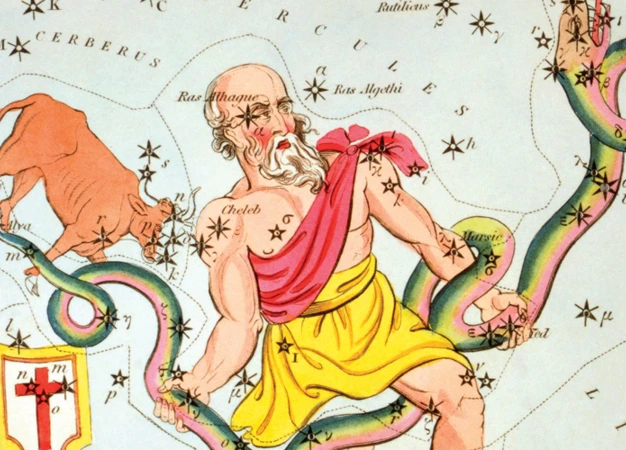Ophiuchus and Medicine: The Connection between Healing and the Serpent Bearer
In the realm of medicine, there are ancient symbols that hold profound significance. Ophiuchus, known as the Serpent Bearer, is one such symbol that has captivated the human imagination throughout history. This enigmatic figure, represented by a man holding a serpent, intertwines with various aspects of healing and well-being. From ancient texts to modern medical iconography, Ophiuchus has left a remarkable imprint on the understanding of medicine. In this article, we will explore the rich tapestry of Ophiuchus in relation to medicine, uncovering its historical references, symbolism, and its influence in both traditional and alternative healing practices. We will also delve into the controversy surrounding Ophiuchus as the 13th zodiac sign and its place in astrology. Additionally, we will examine the role of Ophiuchus as a symbol of healing in medical associations and education. Join us on this journey as we unravel the mesmerizing connection between Ophiuchus and medicine.
Contents
- Ophiuchus: The Serpent Bearer
- Ophiuchus in Ancient Medicine
- The Healing Powers of Ophiuchus
- Ophiuchus in Modern Medicine
- Ophiuchus and Astrology
- Ophiuchus and Medical Associations
- Conclusion
-
Frequently Asked Questions
- 1. What does the constellation Ophiuchus represent?
- 2. Is Ophiuchus a recognized zodiac sign?
- 3. What is the mythology behind Ophiuchus?
- 4. How does Ophiuchus relate to traditional medicine?
- 5. Can Ophiuchus be seen in the night sky?
- 6. What is the significance of the serpent in Ophiuchus?
- 7. How does Ophiuchus influence alternative healing practices?
- 8. Is there a specific medical association linked to Ophiuchus?
- 9. Are there any educational references to Ophiuchus in medical programs?
- 10. How can understanding Ophiuchus benefit our understanding of medicine?
- References
-
Frequently Asked Questions
- 1. How is Ophiuchus connected to medicine?
- 2. What are some historical references to Ophiuchus in medicine?
- 3. What does Ophiuchus symbolize in relation to medicine?
- 4. What can we learn from Ophiuchus in terms of healing?
- 5. How is Ophiuchus related to traditional medicine?
- 6. How is Ophiuchus involved in alternative healing practices?
- 7. How is Ophiuchus depicted in medical iconography?
- 8. What does Ophiuchus symbolize in terms of healing?
- 9. How does Ophiuchus relate to astrology and holistic health?
- 10. How is Ophiuchus used as a medical emblem?
- References
- Read More
Ophiuchus: The Serpent Bearer
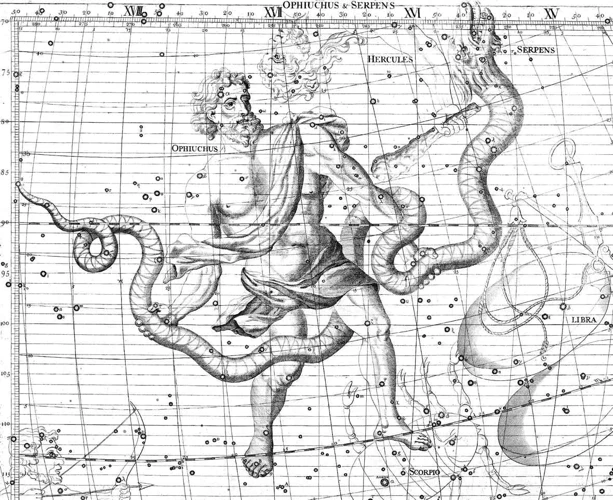
Ophiuchus, also known as the Serpent Bearer, is a captivating figure in mythology and astrology. Depicted as a man holding a serpent, this constellation is steeped in symbolism and mystique. Ophiuchus is often associated with the Greek myth of Asclepius, the god of medicine and healing. Legend has it that Asclepius possessed the ability to resurrect the dead, leading to the anger of Zeus, who struck him down with a thunderbolt. As a tribute to Asclepius, Ophiuchus was placed in the heavens as a constellation. This celestial symbol represents the power of healing and the intertwining of wisdom and serpents, which were seen as symbols of rejuvenation and rebirth. The serpent, being able to shed its skin, became a potent emblem of healing and transformation. Ophiuchus, the Serpent Bearer, stands as a reminder of the healing potential within us all, and the interconnection between the divine and the earthly realms. To delve deeper into the mythology and significance of Ophiuchus, you can explore the fascinating history and stories associated with it.
Ophiuchus in Ancient Medicine
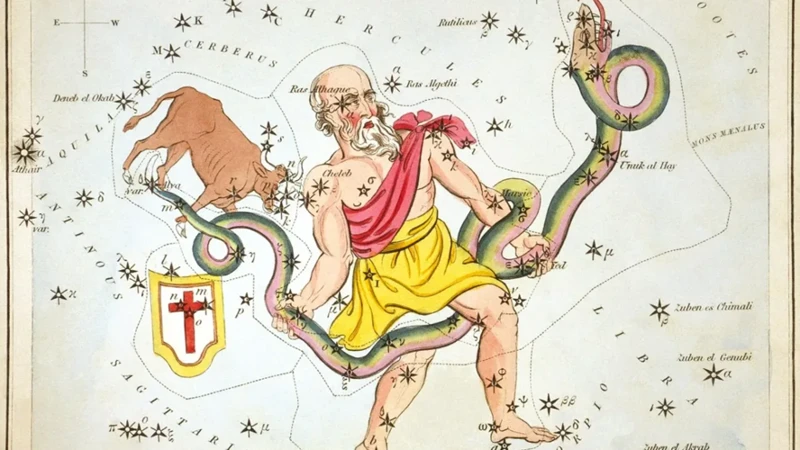
In ancient medicine, Ophiuchus played a significant role in various cultures and healing practices. The connection between this constellation and medicine can be traced back to ancient references and symbolisms.
1. Historical References: Ophiuchus finds mention in ancient texts such as the Babylonian star catalogues and Greek mythology. These references highlight the association between Ophiuchus and healing abilities, often personified by the god Asclepius in Greek mythology. Asclepius, considered the father of medicine, was depicted with a staff entwined by a serpent, which has become the symbol of modern medicine.
2. Symbolism and Interpretations: Ophiuchus symbolizes wisdom, healing, and the quest for spiritual enlightenment. The serpent, a key element in this constellation, represents rebirth, regeneration, and the shedding of old skin. In ancient cultures, the serpent was believed to possess medicinal properties and was associated with healing rituals. The imagery of Ophiuchus served as a reminder to healers and physicians of the transformative power of medicine and the importance of the mind-body-spirit connection.
The ancient significance of Ophiuchus in medicine provides a glimpse into the rich tapestry of beliefs and practices that shaped the healing arts. To explore further the mythology surrounding Ophiuchus and its role in ancient medicine, you can delve into the fascinating stories and legends that have endured through time.
1. Historical References
Historical references to Ophiuchus can be found in various ancient civilizations and cultures. In Greek mythology, Ophiuchus is associated with the story of Asclepius, the god of medicine and healing. Asclepius was revered for his remarkable ability to heal the sick and even resurrect the dead. The Romans also revered the serpent-bearing figure, associating him with their own deity of medicine, Aesculapius. In Egyptian mythology, the constellation of Ophiuchus was linked to the god Imhotep, who was regarded as a healer and a wise sage. Additionally, in Indian mythology, Ophiuchus is considered to represent the sage Dhanvantari, who is revered as the god of Ayurvedic medicine. These historical references highlight the significance of Ophiuchus as a symbol of healing and wisdom across different cultures and time periods. To gain a deeper understanding of the mythology and cultural significance of Ophiuchus, exploring its historical roots can provide valuable insights.
2. Symbolism and Interpretations
Symbolism and Interpretations
The symbolism surrounding Ophiuchus, the Serpent Bearer, is rich and varied, offering multiple interpretations across different cultures and belief systems. In Greek mythology, the serpent represents rebirth, transformation, and wisdom. It is often associated with the god Asclepius, who is depicted with a staff entwined by a serpent, known as the Rod of Asclepius, which has become a universal symbol for medicine. The intertwining of the serpent around the staff signifies the balance and harmony between life and death, illness and healing. The staff itself represents power and authority in the realm of medicine.
In other cultures, such as ancient Egyptian mythology, serpents were revered as symbols of protection and divine knowledge. The serpent deity Wadjet, depicted as a cobra or as a woman with the head of a cobra, was believed to possess the power of healing and guarding against evil spirits. The image of the serpent as a guardian and healer resonates with the essence of Ophiuchus as the Serpent Bearer.
Ophiuchus is also associated with esoteric interpretations. In astrology, it is regarded as the 13th zodiac sign, representing individuals born between November 29th and December 17th. These individuals are believed to possess traits such as wisdom, healing abilities, and a deep connection to spirituality. Some astrologers view Ophiuchus as a transformative force, offering opportunities for personal growth and healing.
The symbolic nature of Ophiuchus extends beyond mythology and astrology. It serves as a reminder of the intertwining relationship between humanity and the natural world, highlighting the importance of balance, evolution, and the pursuit of knowledge. To explore more about the symbolism and interpretations of Ophiuchus, you can delve into the fascinating realm of mythology and astrology, where ancient wisdom and modern interpretations converge.
The Healing Powers of Ophiuchus

The healing powers attributed to Ophiuchus are both profound and multifaceted. From ancient times to the present day, this symbol has served as a source of inspiration and wisdom in the realm of medicine. Lessons from Ophiuchus highlight the importance of embracing the transformative power of healing and the connection between the mind, body, and spirit. In traditional medicine, Ophiuchus is seen as a guiding force, offering insights into the intricate nature of illnesses and the balance required for optimal well-being. Additionally, Ophiuchus plays a significant role in alternative healing practices, where its symbolism is used to tap into ancient knowledge and harness the innate healing potential within individuals. By delving into the mythology and symbolism associated with Ophiuchus, one can gain a deeper understanding of its profound influence on the art of healing. To explore the intriguing history and stories surrounding Ophiuchus, you can delve into the rich world of mythology and its connections to this enigmatic figure.
1. Lessons from Ophiuchus
Lessons from Ophiuchus offer profound insights into the realm of healing and medicine. As the Serpent Bearer, Ophiuchus represents the inherent wisdom and transformative power of healing. One lesson we can glean from Ophiuchus is the importance of embracing the dualities of life. Just as Ophiuchus holds both the serpent and the symbol of healing, we too must understand that healing often requires us to confront and integrate both light and shadow aspects of ourselves. The serpent, a symbol of regeneration and shedding of old skin, teaches us the value of transformation and growth. In embracing the lessons of Ophiuchus, we are reminded that healing is a journey of self-discovery and empowerment. It encourages us to tap into our own inner wisdom and innate healing abilities. Exploring the mythology and symbolism of Ophiuchus can further deepen our understanding of these lessons and provide us with guidance on our own healing journeys.
2. Ophiuchus and Traditional Medicine
Ophiuchus has long been intertwined with traditional forms of medicine, drawing inspiration from its symbolism and association with healing. In various ancient cultures, the serpent bearer has been revered as a symbol of medical wisdom and expertise. In Greek medicine, Ophiuchus represented the god Asclepius, who was revered as the deity of healing and medicine. Temples dedicated to Asclepius, called Asclepieia, were places of pilgrimage where people sought divine intervention for their ailments. These sanctuaries were known for their therapeutic methods, which involved a combination of physical treatments, dream analysis, and spiritual rituals. The staff of Asclepius, a snake-entwined rod, became a well-known symbol for the medical profession and is still used as the emblem of many medical organizations today. Traditional medical practices often embraced the principles of Ophiuchus, recognizing the vital connection between healing, wisdom, and the natural world. Ancient healers drew upon the healing properties of plants and herbs, many of which were associated with serpents and the concept of rejuvenation. From the Ayurvedic traditions of India to the shamanic practices of indigenous cultures, the symbolic power of Ophiuchus has permeated traditional medicine throughout history. Exploring the rich history and mythology behind Ophiuchus can shed further light on its enduring influence on traditional healing practices.
3. Ophiuchus in Alternative Healing
3. Ophiuchus in Alternative Healing
Ophiuchus, the Serpent Bearer, holds a significant place in alternative healing practices. In various holistic traditions, the serpent is seen as a powerful symbol of transformation, wisdom, and renewal. This symbolism resonates with the concept of healing and the restoration of balance in the body, mind, and spirit. Alternative healing modalities often draw inspiration from Ophiuchus in their approach to well-being.
One example is the practice of snake venom therapy, also known as Ophidian therapy, which harnesses the healing properties of snake venom for therapeutic purposes. While this may seem counterintuitive, proponents of snake venom therapy believe that it can stimulate the immune system, relieve pain, and promote healing. The serpent, represented by Ophiuchus, becomes a source of medicinal wisdom and natural remedies.
Another interpretation of Ophiuchus in alternative healing revolves around Kundalini energy. Kundalini, depicted as a coiled serpent, is believed to reside at the base of the spine and represents dormant spiritual energy. According to practitioners, activating this energy through specialized breathing techniques and meditation can lead to profound healing and spiritual awakening. The connection to Ophiuchus lies in the serpent symbolism, symbolizing the awakening and ascent of energy for healing and enlightenment.
In holistic medicine, Ophiuchus is also associated with the concept of regenerative medicine, which utilizes the body’s natural healing abilities to repair or replace damaged cells, tissues, or organs. This aligns with the serpent’s shedding of its skin, symbolizing renewal and regeneration. By embracing the principles embodied by Ophiuchus, practitioners of alternative healing seek to tap into the inherent wisdom and healing potential within each individual.
It is important to note that while alternative healing practices can be complementary to conventional medicine, they should be approached with caution and in conjunction with guidance from qualified healthcare professionals. The inclusion of Ophiuchus in alternative healing further adds depth and symbolism to these holistic approaches, highlighting the interconnectedness between nature, transformation, and the healing arts. To explore more about the mythology and symbolism surrounding Ophiuchus, you can read our article “Exploring Ophiuchus Mythology”.
Ophiuchus in Modern Medicine

Ophiuchus continues to have a presence in modern medicine, albeit in a different form. In medical iconography, Ophiuchus is often depicted as a symbol of healing and the medical profession itself. The Serpent Bearer can be found in various medical logos, representing the profession’s commitment to wellness and the restoration of health. The association between Ophiuchus and medicine serves as a reminder of the historical link between healing and serpents, as well as the importance of wisdom and knowledge in the medical field. Ophiuchus, with its intertwined symbolism of serpents and healing, resonates with medical professionals who strive to alleviate suffering and promote well-being. It is a testament to the enduring power of ancient symbols and their ability to inspire and guide even in the modern age. To learn more about the origins and influence of Ophiuchus in medicine, one can explore the rich history of Roman mythology and its impact on medical symbolism.
1. Ophiuchus in Medical Iconography
In the realm of medical iconography, Ophiuchus holds a prominent place. The symbol of Ophiuchus, the Serpent Bearer, often finds its way into medical institutions, representing the healing arts and the pursuit of wellness. One common depiction of Ophiuchus in medical iconography is the rod of Asclepius, which features a staff with a single serpent coiled around it. This symbol is widely recognized as the emblem of medicine and is often seen on medical certificates, hospital signage, and even the uniforms of healthcare professionals. The use of Ophiuchus in medical iconography serves as a visual reminder of the connection between medicine and the serpent bearer’s healing powers. It reinforces the importance of ancient wisdom and the pursuit of well-being in the field of healthcare. By incorporating the symbol of Ophiuchus in medical iconography, medical practitioners pay homage to the rich history of healing and embrace the timeless ability of the serpent bearer to bring forth healing and renewal. To further explore the fascinating origins and stories behind Ophiuchus, you can delve into the intriguing history of Roman mythology.
2. Ophiuchus as a Symbol of Healing
Ophiuchus, the Serpent Bearer, holds profound symbolism as a symbol of healing. In ancient mythology and astrology, the figure of Ophiuchus is closely associated with the Greek god of medicine, Asclepius. Asclepius was renowned for his ability to heal the sick and even bring the dead back to life. This connection has solidified Ophiuchus’ association with healing and the medical profession. The serpent, which Ophiuchus holds, is a powerful symbol of rejuvenation and transformation. It represents the shedding of old skin and the renewal of life, much like the process of healing. The serpent’s ability to heal itself from injuries further emphasizes the regenerative qualities associated with Ophiuchus. This symbolism is deeply ingrained in various cultures and has transcended time, making Ophiuchus a universally recognized emblem of healing. Today, Ophiuchus continues to inspire medical professionals and those seeking healing, reminding them of the potential for transformation and renewal in the face of illness or adversity. To learn more about the rich history of healing traditions and the significance of Ophiuchus, you can explore the fascinating stories and beliefs surrounding the constellation.
Ophiuchus and Astrology
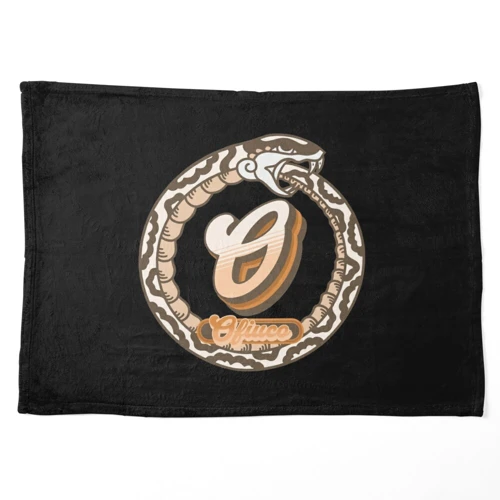
Ophiuchus has sparked controversy and intrigue in the realm of astrology. Traditionally, the zodiac system consists of twelve signs, each representing different personality traits and characteristics. However, Ophiuchus, also known as the 13th zodiac sign, has emerged as a point of contention. Some astrologers argue that Ophiuchus should be included in the zodiac due to its celestial position and influence on human lives. This additional sign, represented by the Serpent Bearer, has its own unique set of attributes and qualities, further expanding the intricacies of astrological interpretation. However, it is essential to note that the inclusion of Ophiuchus remains a subject of debate, with arguments regarding its impact on personal horoscopes and astrological charts. Regardless of its status within the zodiac, the use of Ophiuchus in astrology continues to captivate and challenge our understanding of the celestial world. To explore more about the controversy surrounding the 13th zodiac sign and its potential significance in holistic health, you can delve into the intriguing world of Ophiuchus and its interplay with astrology.
1. The Controversy of the 13th Zodiac Sign
1. The Controversy of the 13th Zodiac Sign
The inclusion of Ophiuchus as a potential 13th zodiac sign has been a subject of heated debate and controversy in astrology. Traditionally, the zodiac consists of twelve signs, each corresponding to a specific period of the year. However, with the discovery of Ophiuchus as a constellation, some astrologers argue that it should be recognized as an additional zodiac sign, shifting the entire astrological calendar. This controversy stems from the fact that if Ophiuchus were to be acknowledged, the dates associated with each zodiac sign would change, altering the astrological personalities and traits attributed to individuals. Supporters of the 13th zodiac sign argue for its inclusion, believing that it offers a more accurate representation of a person’s astrological profile. Skeptics, on the other hand, emphasize the long-standing tradition and symbolism of the twelve zodiac signs and question the validity of incorporating Ophiuchus. While the debate continues, it is important to note that astrology remains a deeply personal and subjective practice, with individuals choosing to align themselves with whichever zodiac system resonates with them. To explore more about the origin and history of astrology and its connection to Ophiuchus, you can delve into the fascinating world of Roman mythology.
2. Ophiuchus and Holistic Health
Holistic health encompasses the idea of treating the whole person – mind, body, and spirit – rather than just the symptoms or specific areas of the body. Ophiuchus, with its deep connections to healing and wisdom, is often associated with the principles of holistic health. This approach to well-being recognizes the interplay between various aspects of an individual’s life and seeks to restore balance and harmony. Just as Ophiuchus holds the serpent, symbolizing transformation and renewal, holistic health aims to facilitate growth and healing on multiple levels. It recognizes that physical ailments can be influenced by emotional, mental, and spiritual factors, and seeks to address the root causes of imbalance rather than merely treating symptoms. The holistic perspective aligns with the ancient wisdom of Ophiuchus, emphasizing the importance of inner healing and self-discovery. By embracing the principles of Ophiuchus in holistic health practices, individuals can embark on a transformative journey towards optimal well-being. To learn more about the origins and history of Ophiuchus and its relevance to holistic health, explore the fascinating stories and myths associated with this celestial symbol.
Ophiuchus and Medical Associations
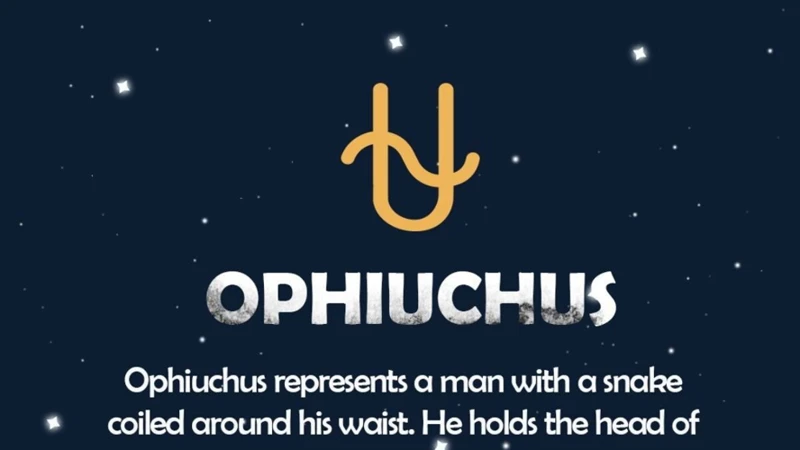
Ophiuchus, the Serpent Bearer, has found its place within various medical associations, serving as a symbol of healing and transformation. In the realm of medicine, Ophiuchus is often adopted as an emblem, representing the pursuit of knowledge and the power of medicine to restore health. Some medical organizations and institutions incorporate the image of Ophiuchus into their logos or signage, signifying their commitment to compassionate care and the healing arts. Additionally, the Ophiuchus symbol is sometimes utilized in the context of medical education, where it serves as a reminder of the importance of the human connection in the healing process. The inclusion of Ophiuchus in medical associations reinforces the significance of this ancient symbol in the modern healthcare landscape. To further explore the connection between Ophiuchus and its role in medical associations, you can delve into its symbolism and significance.
1. Ophiuchus as a Medical Emblem
Ophiuchus has long been regarded as a powerful medical emblem, representing healing and the pursuit of medical knowledge. The association between Ophiuchus and medicine can be traced back to ancient times. In ancient Rome, for example, Ophiuchus was connected with the god of medicine, Asclepius, and his healing temples called Asclepieions. These temples were places of refuge and healing, where individuals sought cures for their ailments. The symbol of a serpent entwined around a staff, known as the Rod of Asclepius, became closely associated with Ophiuchus and medicine. To this day, the Rod of Asclepius is widely recognized as a symbol of the medical profession.
In addition to its connection with Asclepius, Ophiuchus has also been embraced by various medical organizations and associations. The intertwined serpent and staff symbol can often be seen in medical logos, emblems, and even on the uniforms of healthcare professionals. This emblem serves as a visual representation of the healing arts and the commitment to improving health and well-being.
The symbolism of Ophiuchus as a medical emblem extends beyond its visual representation. It embodies the principles of balance, wisdom, and transformation. The serpent, a central element of Ophiuchus, is often associated with rebirth and regeneration. This notion aligns with the healing process, where individuals seek to overcome illness and emerge rejuvenated.
The presence of Ophiuchus as a medical emblem serves as a reminder of the profound link between ancient wisdom and modern medicine. It embodies the timeless pursuit of healing and the noble ideals of the medical profession. To delve deeper into the symbolism and significance of Ophiuchus as a medical emblem, exploring the rich history of Roman mythology can provide further insights into its origins and evolution.
2. The Ophiuchus Sign in Medical Education
The Ophiuchus sign holds significance not only in ancient mythology and modern astrology but also in the realm of medical education. The symbolism of Ophiuchus, the Serpent Bearer, resonates deeply within medical institutions, where its presence serves as a reminder of the noble profession and the responsibility that comes with it. In medical schools, the symbol of Ophiuchus can often be found as a part of the medical emblem, alongside other common medical symbols such as the caduceus and the Rod of Asclepius. These emblems are prominently displayed on uniforms, medical equipment, and even in educational materials. The presence of Ophiuchus in medical education symbolizes the healing power and the lifelong quest for knowledge and wisdom that medical practitioners embody. It reminds aspiring doctors and healthcare professionals of the sacred duty they possess in alleviating suffering and promoting well-being. By incorporating Ophiuchus into medical education, institutions honor the deep-rooted connection between the Serpent Bearer and the healing arts. To learn more about the origin and history of the serpent bearer in roman mythology and its relevance to medical education, explore the fascinating stories and legends associated with it.
Conclusion

In conclusion, Ophiuchus, the Serpent Bearer, holds a significant place in the realm of medicine and healing. From ancient times to the present day, this symbol of wisdom, rejuvenation, and transformation has intrigued and influenced medical practices. The historical references and interpretations of Ophiuchus reveal its connection to ancient healing traditions and the symbolism surrounding serpents. Lessons from Ophiuchus remind us of the potential for healing within ourselves and the importance of our interconnectedness with the divine and natural world.
In modern medicine, Ophiuchus is seen in medical iconography as a representation of healing and the pursuit of wellness. It serves as a reminder to medical professionals to uphold the principles of compassion, knowledge, and care in their practice. Ophiuchus also holds a place in alternative healing, where the symbolic significance of the serpent as a symbol of transformation aligns with various holistic approaches to health and well-being.
The controversy surrounding Ophiuchus as the 13th zodiac sign adds another layer to its significance. While not recognized by traditional Western astrology, Ophiuchus finds a place in holistic health practices that focus on a more holistic understanding of the celestial influences on human well-being.
Furthermore, Ophiuchus has been adopted as a symbol in medical associations, representing the healing arts and the dedication of healthcare professionals. It serves as a reminder of the importance of the human touch and compassion in the field of medicine.
In medical education, the inclusion of Ophiuchus in curriculum and discussions allows for a broader understanding of the historical and symbolic aspects of medicine. It encourages students to explore the rich tapestry of healing practices and consider the interconnectedness between mind, body, and spirit.
In summary, Ophiuchus, the Serpent Bearer, is a symbol that transcends time and continues to weave its influence in the world of medicine. Whether through historical references, symbolism, or its impact on traditional and alternative healing practices, Ophiuchus reminds us of the profound connection between healing and the wisdom of the ages. By embracing the lessons and symbolism of Ophiuchus, we can cultivate a deeper understanding of our own healing potential and the interconnectedness of all living things.
Frequently Asked Questions

1. What does the constellation Ophiuchus represent?
The constellation Ophiuchus represents the Serpent Bearer, a figure from mythology associated with healing and wisdom.
2. Is Ophiuchus a recognized zodiac sign?
Ophiuchus is not officially recognized as one of the 12 zodiac signs in Western astrology. However, it has gained attention and controversy as a possible 13th zodiac sign.
3. What is the mythology behind Ophiuchus?
Ophiuchus is connected to the Greek myth of Asclepius, the god of medicine. Asclepius possessed great healing abilities and was depicted holding a serpent, which became a symbol of rejuvenation and transformation.
4. How does Ophiuchus relate to traditional medicine?
Ophiuchus has historical references within traditional medicine, symbolizing the power of healing and the intertwining of knowledge and serpents. It serves as a reminder of the healing potential within humanity.
5. Can Ophiuchus be seen in the night sky?
Yes, Ophiuchus is visible in the night sky in the Northern Hemisphere during certain times of the year. It can be found between the constellations of Scorpius and Sagittarius.
6. What is the significance of the serpent in Ophiuchus?
The serpent in Ophiuchus represents rebirth and rejuvenation. In ancient beliefs, serpents were seen as symbols of healing and transformation, shedding their skin and rejuvenating themselves.
7. How does Ophiuchus influence alternative healing practices?
In alternative healing practices, Ophiuchus is often associated with energy healing and spiritual transformation. It is believed to facilitate the release of stagnant energy and promote balance within the body and mind.
8. Is there a specific medical association linked to Ophiuchus?
While there isn’t a specific medical association solely dedicated to Ophiuchus, the constellation has been used as a symbol of healing and is occasionally incorporated into medical emblems and logos.
9. Are there any educational references to Ophiuchus in medical programs?
Ophiuchus is sometimes referenced in medical education to highlight the historical and symbolic significance of healing. It serves as a reminder of the ancient roots and traditions of medicine.
10. How can understanding Ophiuchus benefit our understanding of medicine?
Exploring the connection between Ophiuchus and medicine can expand our understanding of the rich history and symbolism behind healing practices. It can give us insights into the holistic and interconnected nature of medicine and the potential within each individual to heal and transform.
References
Frequently Asked Questions

1. How is Ophiuchus connected to medicine?
Ophiuchus has long been associated with healing and medicine. In ancient times, this constellation represented a great healer who possessed the knowledge and power to cure illnesses.
2. What are some historical references to Ophiuchus in medicine?
Historical references to Ophiuchus in medicine can be found in various ancient texts such as the Egyptian Book of the Dead and the writings of Greek physicians like Hippocrates and Galen. These references highlight the importance of the serpent bearer in healing practices.
3. What does Ophiuchus symbolize in relation to medicine?
Ophiuchus symbolizes the power of healing and the ability to bring balance and harmony to the body and mind. The serpent bearer’s symbol, the rod of Asclepius, has become widely recognized as a symbol of medicine.
4. What can we learn from Ophiuchus in terms of healing?
Ophiuchus teaches us the importance of seeking knowledge and understanding in the pursuit of healing. It reminds us to tap into our inner wisdom and find ways to restore balance and wellness in our lives.
In traditional medicine, Ophiuchus represents a holistic approach to healing. It emphasizes the interconnectedness of the body, mind, and spirit, and the importance of addressing the root causes of illness rather than just the symptoms.
6. How is Ophiuchus involved in alternative healing practices?
Alternative healing practices often draw inspiration from Ophiuchus, seeing it as a source of spiritual and energetic healing. Some healing modalities incorporate the symbolism of the serpent bearer to promote physical, emotional, and spiritual well-being.
7. How is Ophiuchus depicted in medical iconography?
In medical iconography, Ophiuchus is often depicted as a figure holding a serpent-wrapped rod, known as the rod of Asclepius. This symbol is widely recognized as a representation of the medical profession and its commitment to healing.
8. What does Ophiuchus symbolize in terms of healing?
Ophiuchus symbolizes the power of healing and the potential within each individual to bring about healing and restoration. It serves as a reminder that healing is a natural and inherent capability of the human body and mind.
9. How does Ophiuchus relate to astrology and holistic health?
The inclusion of Ophiuchus as a zodiac sign in astrology has sparked debates and discussions about its implications for holistic health. Some practitioners believe that this addition enhances the understanding of an individual’s holistic well-being by considering the influence of Ophiuchus in their birth chart.
10. How is Ophiuchus used as a medical emblem?
Ophiuchus is often used as a medical emblem, appearing on flags, badges, and other insignia of medical organizations. It is a constant reminder of the healing arts and the commitment of medical professionals to the well-being of their patients.
References
- Ophiuchus
- The mystery of the thirteenth constellation of the zodiac and its …
- The mystery of the thirteenth constellation of the … – CMF Blogs

